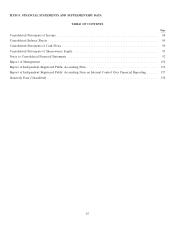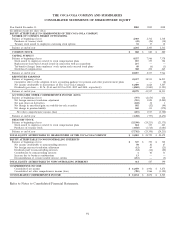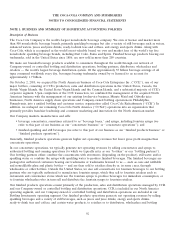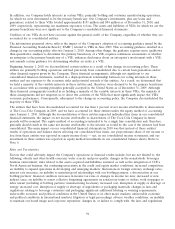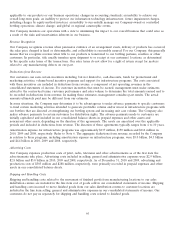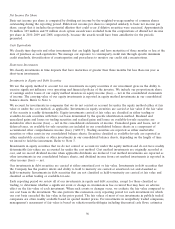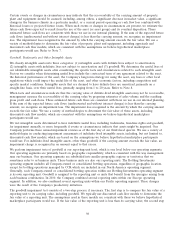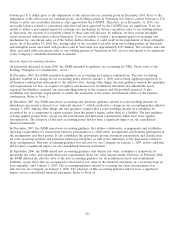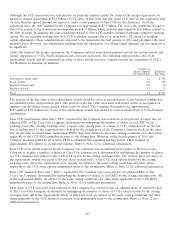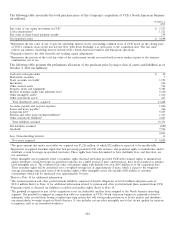Coca Cola 2010 Annual Report Download - page 97
Download and view the complete annual report
Please find page 97 of the 2010 Coca Cola annual report below. You can navigate through the pages in the report by either clicking on the pages listed below, or by using the keyword search tool below to find specific information within the annual report.applicable to our products or our business operations; changes in accounting standards; an inability to achieve our
overall long-term goals; an inability to protect our information technology infrastructure; future impairment charges,
including charges by equity method investees; an inability to successfully manage our Company-owned or controlled
bottling operations; climate change; and global or regional catastrophic events.
Our Company monitors our operations with a view to minimizing the impact to our overall business that could arise as
a result of the risks and uncertainties inherent in our business.
Revenue Recognition
Our Company recognizes revenue when persuasive evidence of an arrangement exists, delivery of products has occurred,
the sales price charged is fixed or determinable, and collectibility is reasonably assured. For our Company, this generally
means that we recognize revenue when title to our products is transferred to our bottling partners, resellers or other
customers. In particular, title usually transfers upon shipment to or receipt at our customers’ locations, as determined
by the specific sales terms of the transactions. Our sales terms do not allow for a right of return except for matters
related to any manufacturing defects on our part.
Deductions from Revenue
Our customers can earn certain incentives including, but not limited to, cash discounts, funds for promotional and
marketing activities, volume-based incentive programs and support for infrastructure programs. The costs associated
with these incentives are included in deductions from revenue, a component of net operating revenues in the
consolidated statements of income. For customer incentives that must be earned, management must make estimates
related to the contractual terms, customer performance and sales volume to determine the total amounts earned and to
be recorded in deductions from revenue. In making these estimates, management considers past results. The actual
amounts ultimately paid may be different from our estimates.
In some situations, the Company may determine it to be advantageous to make advance payments to specific customers
to fund certain marketing activities intended to generate profitable volume and/or invest in infrastructure programs with
our bottlers that are directed at strengthening our bottling system and increasing unit case volume. The Company also
makes advance payments to certain customers for distribution rights. The advance payments made to customers are
initially capitalized and included in our consolidated balance sheets in prepaid expenses and other assets and
noncurrent other assets, depending on the duration of the agreements. The assets are amortized over the applicable
periods and included in deductions from revenue. The duration of these agreements typically ranges from 4 to 10 years.
Amortization expense for infrastructure programs was approximately $137 million, $150 million and $162 million in
2010, 2009 and 2008, respectively. Refer to Note 6. The aggregate deductions from revenue recorded by the Company
in relation to these programs, including amortization expense on infrastructure programs, were $5.0 billion, $4.5 billion
and $4.4 billion in 2010, 2009 and 2008, respectively.
Advertising Costs
Our Company expenses production costs of print, radio, television and other advertisements as of the first date the
advertisements take place. Advertising costs included in selling, general and administrative expenses were $2.9 billion,
$2.8 billion and $3.0 billion in 2010, 2009 and 2008, respectively. As of December 31, 2010 and 2009, advertising and
production costs of $305 million and $288 million, respectively, were primarily recorded in prepaid expenses and other
assets in our consolidated balance sheets.
Shipping and Handling Costs
Shipping and handling costs related to the movement of finished goods from manufacturing locations to our sales
distribution centers are included in the line item cost of goods sold in our consolidated statements of income. Shipping
and handling costs incurred to move finished goods from our sales distribution centers to customer locations are
included in the line item selling, general and administrative expenses in our consolidated statements of income. Our
customers do not pay us separately for shipping and handling costs related to finished goods.
95




